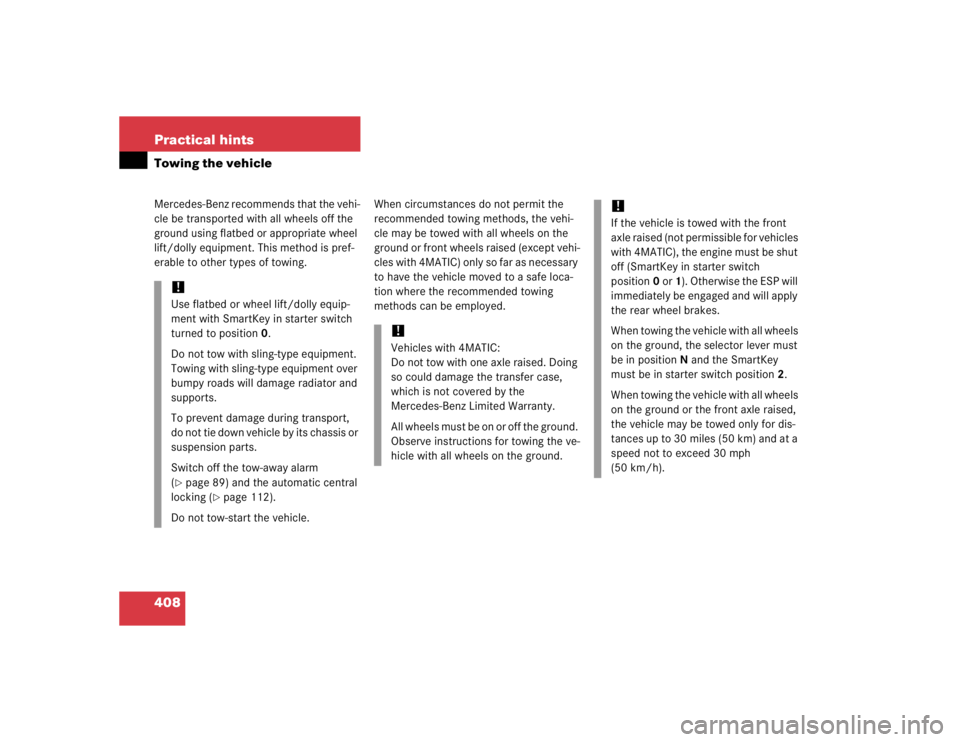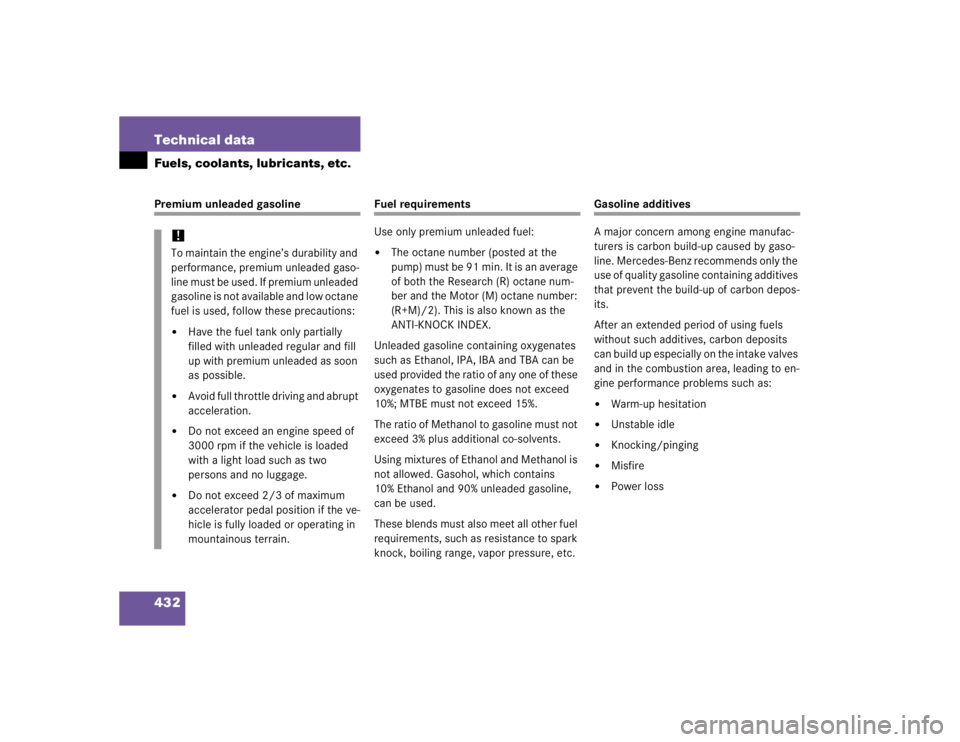Page 362 of 474
360 Practical hintsWhat to do if …?Display
Possible cause
Possible solution
Ï
COOLANT
STOP, ENGINE OFF
The poly-V-belt could be broken.
�
Stop immediately and check the
poly-V-belt.
If it is broken:
�
Do not continue to drive. Otherwise the
engine will overheat due to an inoperative
water pump which may result in damage
to the engine.
�
Notify an authorized Mercedes-Benz Cen-
ter.
If it is intact:
�
Restart the engine only after the message
disappears from the multifunction dis-
play. Doing so could result in serious en-
gine damage that is not covered by the
Mercedes-Benz Limited Warranty.
�
Observe the coolant temperature gauge
(�page 141).
�
Drive immediately to the nearest autho-
rized Mercedes-Benz Center. Adjust driv-
ing to be consistent with reduced braking
responsiveness.
Page 407 of 474
405 Practical hints
Battery
Reconnecting the battery�
Turn off all electrical consumers.
�
Connect the positive lead and fasten its
cover2.
�
Connect negative lead3.Batteries contain materials that can harm
the environment if disposed of improperly.
Large 12-volt storage batteries contain
lead. Recycling of batteries is the preferred
method of disposal. Many states require
sellers of batteries to accept old batteries
for recycling.!Never invert the terminal connections.!The battery, its filler caps and the vent
tube must always be securely installed
when the vehicle is in operation.
iThe following procedures must be car-
ried out following any interruption of
battery power (e.g. due to reconnect-
ing):�
Set the clock (see COMAND opera-
tor’s manual).
�
Synchronize the ESP (
�page 352).
�
Synchronize side windows
(�page 209).
�
Synchronize tilt/sliding sunroof
(�page 213).
Page 410 of 474

408 Practical hintsTowing the vehicleMercedes-Benz recommends that the vehi-
cle be transported with all wheels off the
ground using flatbed or appropriate wheel
lift/dolly equipment. This method is pref-
erable to other types of towing.When circumstances do not permit the
recommended towing methods, the vehi-
cle may be towed with all wheels on the
ground or front wheels raised (except vehi-
cles with 4MATIC) only so far as necessary
to have the vehicle moved to a safe loca-
tion where the recommended towing
methods can be employed.
!Use flatbed or wheel lift/dolly equip-
ment with SmartKey in starter switch
turned to position0.
Do not tow with sling-type equipment.
Towing with sling-type equipment over
bumpy roads will damage radiator and
supports.
To prevent damage during transport,
do not tie down vehicle by its chassis or
suspension parts.
Switch off the tow-away alarm
(�page 89) and the automatic central
locking (
�page 112).
Do not tow-start the vehicle.
!Vehicles with 4MATIC:
Do not tow with one axle raised. Doing
so could damage the transfer case,
which is not covered by the
Mercedes-Benz Limited Warranty.
All wheels must be on or off the ground.
Observe instructions for towing the ve-
hicle with all wheels on the ground.
!If the vehicle is towed with the front
axle raised (not permissible for vehicles
with 4MATIC), the engine must be shut
off (SmartKey in starter switch
position0 or 1). Otherwise the ESP will
immediately be engaged and will apply
the rear wheel brakes.
When towing the vehicle with all wheels
on the ground, the selector lever must
be in positionN and the SmartKey
must be in starter switch position2.
When towing the vehicle with all wheels
on the ground or the front axle raised,
the vehicle may be towed only for dis-
tances up to 30 miles (50 km) and at a
speed not to exceed 30 mph
(50 km/h).
Page 422 of 474

420 Technical dataEngineModel
S 430 (220.070, 220.170)
1
S 430 4MATIC (220.183)
1
1The quoted data apply only to the standard vehicle. See an authorized Mercedes-Benz Center for the corresponding data of all special bodies and special equipment.
S 500 (220.175)
1
S 500 4MATIC (220.184)
1
Engine
113
113
Mode of operation
4-stroke engine, gasoline injection
4-stroke engine, gasoline injection
No. of cylinders
8
8
Bore
3.54 in (89.90 mm)
3.82 in (97.00 mm)
Stroke
3.31 in (84.00 mm)
3.31 in (84.00 mm)
Total piston displacement
260.3 cu in (4266 cm
3)
303.0 cu in (4966 cm
3)
Compression ratio
10:1
10:1
Output acc. to SAE J 1349
275 hp/5750 rpm
2
(205 kW/5750 rpm)
2Premium fuel required. Performance may vary with fuel octane rating.
302 hp/5600 rpm
2
(225 kW/5600 rpm)
Maximum torque
acc. to SAE J 1349
295 lb-ft/3000 - 4400 rpm
(400 Nm/3000 - 4400 rpm)
339 lb-ft/2700 - 4250 rpm
(460 Nm/2700 - 4250 rpm)
Maximum engine speed
6000 rpm
6000 rpm
Firing order
1-5-4-2-6-3-7-8
1-5-4-2-6-3-7-8
Poly-V-belt
2380 mm
2380 mm
Page 423 of 474

421 Technical data
Engine
Model
S 55 AMG (220.174)
1
S 600 (220.176)
1
Engine
113
275
Mode of operation
4-stroke engine, gasoline injection
4-stroke engine, gasoline injection
No. of cylinders
8
12
Bore
3.82 in (97.00 mm)
3.23 in (82.00 mm)
Stroke
3.62 in (92.00 mm)
3.43 in (87.00 mm)
Total piston displacement
331.8 cu in (5439 cm
3)
336.4 cu in (5513 cm
3)
Compression ratio
9:1
9:1
Output acc. to SAE J 1349
493 hp/6100 rpm
2
(368 kW/6100 rpm)
493 hp/5000 rpm
2
(368 kW/5000 rpm)
Maximum torque
acc. to SAE J 1349
516 lb-ft/2750 - 4000 rpm
(700 Nm/2750 - 4000 rpm)
590 lb-ft/1800 - 3500 rpm
(800 Nm/1800 - 3500 rpm)
Maximum engine speed
6500 rpm
5950 rpm
Firing order
1-5-4-2-6-3-7-8
1-12-5-8-3-10-6-7-2-11-4-9
Poly-V-belt
Belt one: 1289 mm
Belt two: 2462 mm
2335 mm
1The quoted data apply only to the standard vehicle. See an authorized Mercedes-Benz Center for the corresponding data of all special bodies and special equipment.2Premium fuel required. Performance may vary with fuel octane rating.
Page 431 of 474

429 Technical data
Fuels, coolants, lubricants, etc.
�Fuels, coolants, lubricants, etc.
CapacitiesVehicle components and their respective
lubricants must match. Therefore use only
brands tested and approved by us.Please refer to the Factory Approved Ser-
vice Products pamphlet, or inquire at your
Mercedes-Benz Center.
Model
Capacity
Fuels, coolants, lubricants, etc.
Engine with oil filter
S 430
S 500
S 55 AMG
S 600
8.5 US qt. (8.0 l)
8.5 US qt. (8.0 l)
7.9 US qt. (7.5 l)
9.5 US qt. (9.0 l)
Approved engine oils
Automatic transmission
S 600
9.1 US qt. (8.6 l)
8.1 US qt. (7.7 l)
MB Automatic Transmission Fluid
Rear axle
S55AMG
S 600
1.7 US qt. (1.6 l)
2.1 US qt. (2.0 l)
2.1 US qt. (2.0 l)
Hypoid gear oil SAE 85 W 90
Front axle
S 430 4MATIC
S 500 4MATIC
0.63 US qt. (0.6 l)
Hypoid gear oil SAE 85 W 90
Transfer case
S 430 4MATIC
S 500 4MATIC
0.62 US qt. (0.585 l)
MB Transfer Case Oil
Hydraulic system for ADS or ABC
4.2 US qt. (4.0 l)
MB Hydraulic Fluids
Power steering
approx. 1.1 US qt. (1.0 l)
MB Power Steering Fluid (Pentosin
CHF 11S)
Page 434 of 474

432 Technical dataFuels, coolants, lubricants, etc.Premium unleaded gasoline
Fuel requirements
Use only premium unleaded fuel:�
The octane number (posted at the
pu mp ) m ust b e 91 m i n. It is an a ve ra ge
of both the Research (R) octane num-
ber and the Motor (M) octane number:
(R+M)/2). This is also known as the
ANTI-KNOCK INDEX.
Unleaded gasoline containing oxygenates
such as Ethanol, IPA, IBA and TBA can be
used provided the ratio of any one of these
oxygenates to gasoline does not exceed
10%; MTBE must not exceed 15%.
The ratio of Methanol to gasoline must not
exceed 3% plus additional co-solvents.
Using mixtures of Ethanol and Methanol is
not allowed. Gasohol, which contains
10% Ethanol and 90% unleaded gasoline,
can be used.
These blends must also meet all other fuel
requirements, such as resistance to spark
knock, boiling range, vapor pressure, etc.
Gasoline additives
A major concern among engine manufac-
turers is carbon build-up caused by gaso-
line. Mercedes-Benz recommends only the
use of quality gasoline containing additives
that prevent the build-up of carbon depos-
its.
After an extended period of using fuels
without such additives, carbon deposits
can build up especially on the intake valves
and in the combustion area, leading to en-
gine performance problems such as:�
Warm-up hesitation
�
Unstable idle
�
Knocking/pinging
�
Misfire
�
Power loss
!To maintain the engine’s durability and
performance, premium unleaded gaso-
line must be used. If premium unleaded
gasoline is not available and low octane
fuel is used, follow these precautions:�
Have the fuel tank only partially
filled with unleaded regular and fill
up with premium unleaded as soon
as possible.
�
Avoid full throttle driving and abrupt
acceleration.
�
Do not exceed an engine speed of
3000 rpm if the vehicle is loaded
with a light load such as two
persons and no luggage.
�
Do not exceed 2/3 of maximum
accelerator pedal position if the ve-
hicle is fully loaded or operating in
mountainous terrain.
Page 439 of 474

437 Technical terms
ABC
(A
ctive B
ody C
ontrol)
Active, computer-controlled system
that hydraulically adjusts the suspen-
sion at all four wheels in response to
various driving situations.
ABS
(A
ntilock B
rake S
ystem)
Prevents the wheels from locking up
during braking so that the vehicle can
continue to be steered.
ADS
(A
daptive D
amping S
ystem)
Automatically adapts the optimum sus-
pension damping to prevailing driving
conditions.
Airmatic
Automatically selects the optimum sus-
pension tuning and ride height for your
vehicle. Airmatic consists of two com-
ponents:
�
Adaptive Damping System
�
Vehicle level controlAlignment bolt
Metal pin with thread. The centering
pin is an aid used when changing a tire
to align the wheel with the wheel hub.
BabySmart
TM air bag deactivation
system
This system detects if a special system
compatible child restraint seat is in-
stalled on the front passenger seat. The
system will automatically deactivate
the passenger front air bag when such
a seat is properly installed (the
58indicator lamp in the center
console comes on). See an authorized
Mercedes-Benz Center for availability.
BabySmartTM compatible child seats
Special restraint system for children.
The sensor system for the passenger
seat prevents deployment of the pas-
senger front air bag if a BabySmart
TM
compatible child seat is installed. See
an authorized Mercedes-Benz Center
for availability.BAS
(B
rake A
ssist S
ystem)
System for potentially reducing braking
distances in emergency braking situa-
tions. The system is activated when it
senses an emergency based on how
fast the brake is applied.
Bi-xenon headlamps
Headlamps which use an electric arc as
the light source and produce a more in-
tense light than filament headlamps.
Bi-xenon headlamps produce low beam
and high beam.
CAC
(C
ustomer A
ssistance C
enter)
Mercedes-Benz customer service cen-
ter, which can help you with any ques-
tions about your vehicle and provide
assistance in the event of a break-
down.